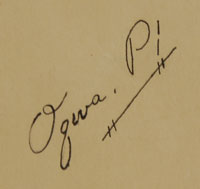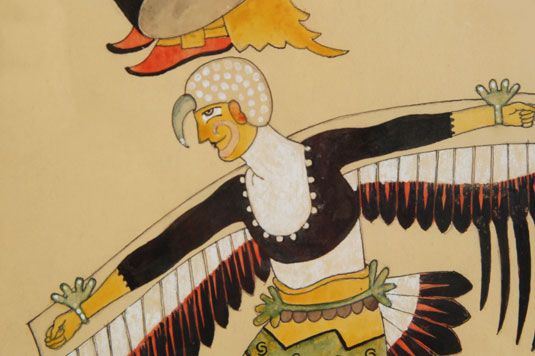Original Pueblo Painting of an Eagle Dance [SOLD]
+ Add to my watchlist Forward to Friend
- Category: Paintings
- Origin: San Ildefonso Pueblo, Po-woh-ge-oweenge
- Medium: Tempera
- Size:
16" x 11-1/2" image;
22-7/8" x 18-1/2" framed - Item # C3874D SOLD
Abel Sanchez (1899-1971) Oqwa Pi - Kachina Stick is important in the history of New Mexico Pueblo painters. He had little formal training—a few classes at the Santa Fe Indian School—but received no other instruction. He painted in a style that might be called naïve, a style developed by Indians without formal instruction. He experimented successfully with figure arrangement and action in a way that very few of his peers even attempted.
Oqwa Pi painted in the traditional flat depictions in vogue at the Santa Fe Indian School of the period. There are no ground planes, nor are there any background plants or features. He faithfully depicted the costuming of the figures, providing a detailed record of the clothing worn during the period. He started painting as early as age 20, or around 1919.
Sanchez was eight times Governor of San Ildefonso Pueblo, was a farmer, and earned enough from sales of his paintings to support a very large family. His works were exhibited at the Milwaukee Art Institute, Yale University, Museum of Modern Art in New York City, Stanford University, and the Gallery of Fine Arts in Muskegon, Michigan. The fresh color, action and great simplicity of his paintings made them well-received in all these exhibits.
 This Original Pueblo Painting of an Eagle Dance is typical of his finest works. The colors are soft, not harsh, and the figures are well drawn without the use of the bold outlines often seen in the works of his contemporaries. The clothing very accurately reflects that of the early part of the 20th century. The eagle dancers at the forefront are depicted with much more attention to detail than those featured in paintings by Sanchez’s peers.
This Original Pueblo Painting of an Eagle Dance is typical of his finest works. The colors are soft, not harsh, and the figures are well drawn without the use of the bold outlines often seen in the works of his contemporaries. The clothing very accurately reflects that of the early part of the 20th century. The eagle dancers at the forefront are depicted with much more attention to detail than those featured in paintings by Sanchez’s peers.
This painting is illustrated on page 216 of Through Their Eyes—Indian Painting in Santa Fe, 1918-1945 by Michelle McGeough, Wheelwright Museum of the American Indian, 2009
Condition: The painting appears to be in original excellent condition. It is framed using acid-free materials, but has not been examined out of the frame. There is no evidence of damage or acid-burn.
Provenance: from the Charlotte G. Mittler collection
Recommended Reading: Through Their Eyes—Indian Painting in Santa Fe, 1918-1945 by Michelle McGeough, Wheelwright Museum of the American Indian, 2009

- Category: Paintings
- Origin: San Ildefonso Pueblo, Po-woh-ge-oweenge
- Medium: Tempera
- Size:
16" x 11-1/2" image;
22-7/8" x 18-1/2" framed - Item # C3874D SOLD



